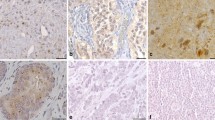Abstract
Background
Recently, paraneoplastic encephalitis associated with ovarian teratoma has been described and related to an autoantibody. Methods: We describe four patients with ovarian teratoma-associated encephalitis (OTE) and compared their clinical pictures with those of 17 previously reported patients with OTE. Results: Clinically, OTE was characterized by the development of acute prominent psychiatric symptoms (20 of 21 patients), seizures (15 of 21 patients), and central hypoventilation (13 of 21 patients). Our patients had hypersalivation (three patients) and cardiac conduction problems (all patients); hypothermia was present in one patient. The mean time from the onset of OTE to tumor diagnosis was 19.6 ± 22.1 weeks. Ventilatory support was required for 54.9 ± 25.4 days on average. The white blood cell count in cerebrospinal fluid was 55.1 ± 61.2/mm3. Twelve patients showed abnormalities on cranial MRI, involving areas such as the temporal regions (seven patients) or brainstem (four patients). In addition to tumor resection, 17 patients received some type of immunotherapy: 17 patients received corticosteroids, 10 received intravenous immunoglobulins, two received cyclophosphamide, seven received plasma exchange. Eighteen patients with OTE had neurological improvement, including 11 with full recovery. Conclusions: OTE presents with cardiac conduction problems and hypersalivation in addition to psychiatric symptoms, seizures, and central hypoventilation.

Similar content being viewed by others
References
Vitaliani R, Mason W, Ances B, Zwerdling T, Jiang Z, Dalmau J (2005) Paraneoplastic encephalitis, psychiatric symptoms, and hypoventilation in ovarian teratoma. Ann Neurol 58:594–604
Bataller L, Kleopa KA, Wu GF, Rossi JE, Rosenfeld MR, Dalmau J. Autoimmune limbic encephalitis in 39 Patients: immunophenotypes and Outcomes. J Neurol Neurosurg Psychiatry (2006), Sep 15 [Epub ahead of print]
Dalmau J, Tuzun E, Wu HY et al (2007) Paraneoplastic anti-N-methyl-d-aspartate receptor encephalitis associated with ovarian teratoma. Ann Neurol 61:25–36
Nokura K, Yamamoto H, Okawara Y, Koga H, Osawa H, Sakai K (1997) Reversible limbic encephalitis caused by ovarian teratoma. Acta Neurol Scand 95:367–373
Aydiner A, Gurvit H, Baral I (1998) Paraneoplastic limbic encephalitis with immature ovarian teratoma–a case report. J Neurooncol 37:63–66
Fadare O, Hart HJ (2004) Anti-Ri antibodies associated with short-term memory deficits and a mature cystic teratoma of the overy. Int Semin Surg Oncol 1:11
Lee AC, Ou Y, Lee WK, Wong YC (2003) Paraneoplastic limbic encephalitis masquerading as chronic behavioural disturbance in an adolescent girl. Acta Paediatr 92:506–509
Taylor RB, Mason W, Kong K, Wennberg R (1999) Reversible paraneoplastic encephalomyelitis associated with a benign ovarian teratoma. Can J Neurol Sci 26:317–320
Stein-Wexler R, Wootton-Gorges SL, Greco CM, Brunberg JA (2005) Paraneoplastic limbic encephalitis in a teenage girl with an immature ovarian teratoma. Pediatr Radiol 35:694–697
Ances BM, Vitaliani R, Taylor RA et al (2005) Treatment-responsive limbic encephalitis identified by neuropil antibodies: MRI and PET correlates. Brain 128:1764–77
Okamura H, Oomori N, Uchitomi Y (1997) An acutely confused 15-year-old girl. Lancet 350:488
Muni RH, Wennberg R, Mikulis DJ, Wong AM (2004) Bilateral horizontal gaze palsy in presumed paraneoplastic brainstem encephalitis associated with a benign ovarian teratoma. J Neuroophthalmol 24:114–118
Koide R, Shimizu T, Koike K, Dalmau J (2007) EFA6A-like antibodies in paraneoplastic encephalitis associated with immature ovarian teratoma: a case report. J Neurooncol 81:71–74
Yang YW, Tsai CH, Chang FC, Lu MK, Chiu PY (2006) Reversible paraneoplastic limbic encephalitis caused by a benign ovarian teratoma: report of a case and review of literatures. J Neurooncol 80:309–312
Dietl HW, Pulst SM, Engelhardt P, Mehraein P (1982) Paraneoplastic brainstem encephalitis with acute dystonia and central hypoventilation. J Neurol 227:229–238
Kaplan AM, Itabashi HH (1974) Encephalitis associated with carcinoma. Central hypoventilation syndrome and cytoplasmic inclusion bodies. J Neurol Neurosurg Psychiatry 37:1166–1176
Nunn K, Ouvrier R, Sprague T, Arbuckle S, Docker M (1997) Idiopathic hypothalamic dysfunction: a paraneoplastic syndrome? J Child Neurol 12:276–281
Dadparvar S, Anderson GS, Bhargava P et al (2003) Paraneoplastic encephalitis associated with cystic teratoma is detected by fluorodeoxyglucose positron emission tomography with negative magnetic resonance image findings. Clin Nucl Med 28:893–896
Hille B (1992) Ionic Channels of exitable membrane. Sinauer Associates, Boston
Liguori R, Vincent A, Clover L et al. (2001) Morvan’s syndrome: peripheral and central nervous system and cardiac involvement with antibodies to voltage-gated potassium channels. Brain 124:2417–2426
Buckley C, Oger J, Clover L et al (2001) Potassium channel antibodies in two patients with reversible limbic encephalitis. Ann Neurol 50:73–78
Serratrice G, Azulay J (1994) Mise au point. Que reste-t-il de la choree fibrilaire de Morvan? Rev Neurol 150:257–265
Hille B (1992) Ionic Channels of exitable membrane. Sinauer Associates, Boston
Ackerman MJ, Clapham DE (1997) Ion channels: basic science and clinical disease. N Engl J Med 336:1575–1586
Acknowledgements
We thank Dr. Keiko Tanaka, Department of Neurology, Brain Research Institute, Niigata University, for evaluation of the anti-neuronal antibodies, and Dr. Kimiyoshi Arimura, Department of Neurology, Kagoshima University, and Dr. Masakatu Motomura, Department of Neurology, Nagasaki University, for evaluation of VGKC antibodies.
Author information
Authors and Affiliations
Corresponding author
Rights and permissions
About this article
Cite this article
Tonomura, Y., Kataoka, H., Hara, Y. et al. Clinical analysis of paraneoplastic encephalitis associated with ovarian teratoma. J Neurooncol 84, 287–292 (2007). https://doi.org/10.1007/s11060-007-9372-9
Received:
Accepted:
Published:
Issue Date:
DOI: https://doi.org/10.1007/s11060-007-9372-9




